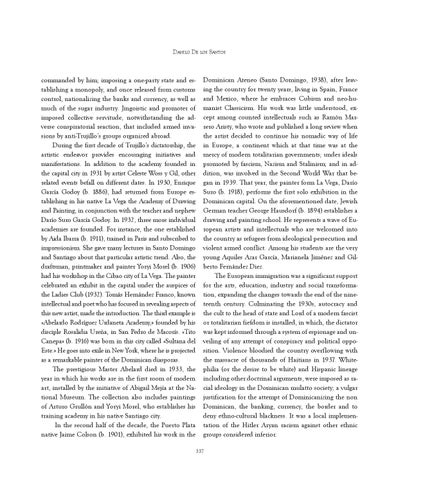Danilo De los Santos
commanded by him; imposing a one-party state and establishing a monopoly, and once released from customs control, nationalizing the banks and currency, as well as much of the sugar industry. Jingoistic and promoter of imposed collective servitude, notwithstanding the adverse conspiratorial reaction, that included armed invasions by anti-Trujillo’s groups organized abroad. During the first decade of Trujillo’s dictatorship, the artistic endeavor provides encouraging initiatives and manifestations. In addition to the academy founded in the capital city in 1931 by artist Celeste Woss y Gil, other related events befall on different dates. In 1930, Enrique García Godoy (b. 1886), had returned from Europe establishing in his native La Vega the Academy of Drawing and Painting, in conjunction with the teacher and nephew Darío Suro García Godoy. In 1932, three more individual academies are founded. For instance, the one established by Aida Ibarra (b. 1911), trained in Paris and subscribed to impressionism. She gave many lectures in Santo Domingo and Santiago about that particular artistic trend. Also, the draftsman, printmaker and painter Yoryi Morel (b. 1906) had his workshop in the Cibao city of La Vega. The painter celebrated an exhibit in the capital under the auspices of the Ladies Club (1932). Tomás Hernández Franco, known intellectual and poet who has focused in revealing aspects of this new artist, made the introduction. The third example is «Abelardo Rodríguez Urdaneta Academy,» founded by his disciple Rosalidia Ureña, in San Pedro de Macorís. «Tito Canepa» (b. 1916) was born in this city called «Sultana del Este.» He goes into exile in New York, where he is projected as a remarkable painter of the Dominican diasporas. The prestigious Master Abelard died in 1933, the year in which his works are in the first room of modern art, installed by the initiative of Abigail Mejía at the National Museum. The collection also includes paintings of Arturo Grullón and Yoryi Morel, who establishes his training academy in his native Santiago city. In the second half of the decade, the Puerto Plata native Jaime Colson (b. 1901), exhibited his work in the
Dominican Ateneo (Santo Domingo, 1938), after leaving the country for twenty years, living in Spain, France and Mexico, where he embraces Cubism and neo-humanist Classicism. His work was little understood, except among counted intellectuals such as Ramón Marrero Aristy, who wrote and published a long review when the artist decided to continue his nomadic way of life in Europe, a continent which at that time was at the mercy of modern totalitarian governments; under ideals promoted by fascism, Nazism and Stalinism; and in addition, was involved in the Second World War that began in 1939. That year, the painter form La Vega, Darío Suro (b. 1918), performs the first solo exhibition in the Dominican capital. On the aforementioned date, Jewish German teacher George Hausdorf (b. 1894) establishes a drawing and painting school. He represents a wave of European artists and intellectuals who are welcomed into the country as refugees from ideological persecution and violent armed conflict. Among his students are the very young Aquiles Azar García, Marianela Jiménez and Gilberto Fernández Diez. The European immigration was a significant support for the arts, education, industry and social transformation, expanding the changes towards the end of the nineteenth century. Culminating the 1930s, autocracy and the cult to the head of state and Lord of a modern fascist or totalitarian fiefdom is installed, in which, the dictator was kept informed through a system of espionage and unveiling of any attempt of conspiracy and political opposition. Violence bloodied the country overflowing with the massacre of thousands of Haitians in 1937. Whitephilia (or the desire to be white) and Hispanic lineage including other doctrinal arguments, were imposed as racial ideology in the Dominican mulatto society; a vulgar justification for the attempt of Dominicanizing the non Dominican, the banking, currency, the border and to deny ethno-cultural blackness. It was a local implementation of the Hitler Aryan racism against other ethnic groups considered inferior. 337
